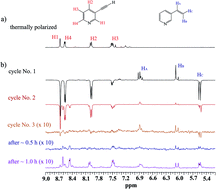Deactivation of catalysts in simultaneous reversible and irreversible parahydrogen NMR signal enhancement, and the role of co-ligands in the stabilization of the reversible method†
Abstract
Signal Amplification by Reversible Exchange (SABRE) and hydrogeneable Parahydrogen Induced Polarization (hPHIP) can enhance weak NMR signals, and thus increase the range of NMR applications. Here, using an N-heterocyclic carbene Ir-based catalyst, simultaneous SABRE and hPHIP was achieved for the compound with an N-donor site and an acetylene triple bond. It was demonstrated that the interplay between SABRE and hPHIP can be manipulated. Specifically, it was found that the hPHIP effect could be almost completely suppressed, while stable SABRE was observed in subsequent consecutive experiments. The presented results have the potential to increase the numbers of parahydrogen hyperpolarizable molecules.



 Please wait while we load your content...
Please wait while we load your content...